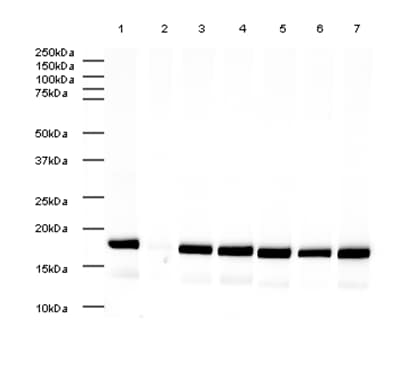Anti-Histone H3 (mono methyl K4) antibody - ChIP Grade (ab8895)
Key features and details
- Rabbit polyclonal to Histone H3 (mono methyl K4) - ChIP Grade
- Suitable for: ICC/IF, ChIP, WB, IHC-P
- Reacts with: Cow, Human
- Isotype: IgG
Overview
-
Product name
Anti-Histone H3 (mono methyl K4) antibody - ChIP Grade
See all Histone H3 primary antibodies -
Description
Rabbit polyclonal to Histone H3 (mono methyl K4) - ChIP Grade -
Host species
Rabbit -
Specificity
Specific for mono-methylated Lysine 4 of histone H3. Does not recognise di- or tri-methyl Lysine 4 nor methylation at Lysine 9. -
Tested Applications & Species
See all applications and species dataApplication Species ChIP HumanICC/IF HumanIHC-P HumanWB Cow -
Immunogen
Synthetic peptide within Human Histone H3 aa 1-100 (mono methyl K4) conjugated to keyhole limpet haemocyanin. The exact sequence is proprietary.
(Peptide available asab1340) -
Positive control
- ChIP: Chromatin prepared from U-2 OS cells; Metastatic clear cell renal carcinoma cells (M1A). WB: Calf thymus histone lysate. ICC/IF: HeLa cells. IHC-P: Human colon tissue.
-
General notes
Learn about ChIP assay kits, other ChIP antibodies, protocols and more in the ChIP assay guide.
Images
-
Chromatin was prepared from U-2 OS cells according to the Abcam X-ChIP protocol. Cells were fixed with formaldehyde for 10min. The ChIP was performed with 25µg of chromatin, 2µg of ab8895 (blue), and 20µl of Protein A/G sepharose beads. No antibody was added to the beads control (yellow). The immunoprecipitated DNA was quantified on the GAPDH and ALDOA (active) and MYO-D (inactive) promoters and over the y-Actin gene (active). Schematic diagram of the y-Actin gene is shown on the top of the figure. Black boxes represent exons and thin lines represent introns. PCR products are depicted as bars under the gene.
-
All lanes : Anti-Histone H3 (mono methyl K4) antibody - ChIP Grade (ab8895) at 1/500 dilution
Lane 1 : Calf thymus histone lysate
Lane 2 : Calf thymus histone lysate withHuman Histone H3 (mono methyl K4) peptide (ab1340) at 1 µg/ml
Lane 3 : Calf thymus histone lysate withHuman Histone H3 (di methyl K4) peptide (ab7768) at 1 µg/ml
Lane 4 : Calf thymus histone lysate withHuman Histone H3 (tri methyl K4) peptide (ab1342) at 1 µg/ml
Lane 5 : Calf thymus histone lysate withHuman Histone H3 (mono methyl K9) peptide (ab1771) at 1 µg/ml
Lane 6 : Calf thymus histone lysate withHuman Histone H3 (mono methyl K27) peptide (ab1780) at 1 µg/ml
Lane 7 : Calf thymus histone lysate withHuman Histone H3 (unmodified ) peptide (ab2903) at 1 µg/ml
Secondary
All lanes : Goat Anti-Rabbit IgG H&L (HRP) (ab6721) at 1/5000 dilution
Performed under reducing conditions.
Predicted band size: 15 kDa
Exposure time: 2 minutesab8895 is specific for mono-methylated Lysine 4 of histone H3 and does not recognize di- or tri-methyl Lysine 4 nor methylation at Lysine 9. This is shown in lane 2 where the activity of the antibody is specifically blocked by the addition of the immunizing peptide (ab1340).
-
 Immunocytochemistry/ Immunofluorescence - Anti-Histone H3 (mono methyl K4) antibody - ChIP Grade (ab8895)
Immunocytochemistry/ Immunofluorescence - Anti-Histone H3 (mono methyl K4) antibody - ChIP Grade (ab8895)ab8895 staining Histone H3 (mono methyl K4) in HeLa cells. The cells were fixed with 100% methanol (5min) and then blocked in 1% BSA/10% normal goat serum/0.3M glycine in 0.1%PBS-Tween for 1h. The cells were then incubated with ab8895 at 1µg/ml and ab7291 (anti beta Tubulin) at 1µg/ml overnight at +4°C, followed by a further incubation at room temperature for 1h with a goat anti-rabbit AlexaFluor®488 secondary (ab150081) at 2 μg/ml (shown in green) and a goat anti-mouse AlexaFluor®594 secondary (ab150120) at 2 μg/ml (shown in pseudo color red). Nuclear DNA was labelled in blue with DAPI.
Negative controls: 1– Rabbit primary antibody and anti-mouse secondary antibody; 2 – Mouse primary antibody and anti-rabbit secondary antibody. Controls 1 and 2 indicate that there is no unspecific reaction between primary and secondary antibodies used.
-
 Immunohistochemistry (Formalin/PFA-fixed paraffin-embedded sections) - Anti-Histone H3 (mono methyl K4) antibody - ChIP Grade (ab8895)
Immunohistochemistry (Formalin/PFA-fixed paraffin-embedded sections) - Anti-Histone H3 (mono methyl K4) antibody - ChIP Grade (ab8895)IHC image of ab8895 staining Histone H3 (mono methyl K4) in human colon formalin fixed paraffin embedded tissue sections, performed on a Leica Bond. The section was pre-treated using heat mediated antigen retrieval with sodium citrate buffer (pH6, epitope retrieval solution 1) for 20 mins. The section was then incubated with ab8895, 0.5µg/ml, for 15 mins at room temperature and detected using an HRP conjugated compact polymer system. DAB was used as the chromogen. The section was then counterstained with haematoxylin and mounted with DPX. No primary antibody was used in the negative control (shown on the inset).
For other IHC staining systems (automated and non-automated) customers should optimize variable parameters such as antigen retrieval conditions, primary antibody concentration and antibody incubation times.
-
ChIP - Anti-Histone H3 (mono methyl K4) antibody - ChIP Grade (ab8895) This image is courtesy of an Abreview submitted by Paulo Rodrigues
ChIP analysis using ab8895 binding Histone H3 (mono methyl K4) in Metastatic clear cell renal carcinoma cells (M1A). Cells were cross-linked for 10 minutes with 1% formaldehyde. Samples were incubated at 1/100 dilution with primary antibody for 12 hours at 4°C.
Positive control:Metastatic clear cell renal carcinoma cells (M1A).
Negative Control:Parental clear cell renal carcinoma cells (786-O).























